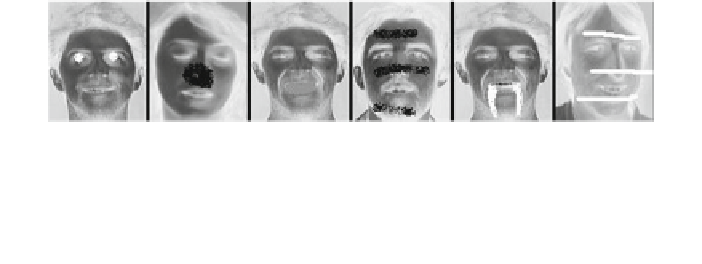Information Technology Reference
In-Depth Information
Fig. 7.12
Occluded images, recognized by both
PCA
-based recognition system as well by both
ICA
-based recognition system
Fig. 7.13
Occluded images, not recognized by any
PCA
-based recognition system but correctly
identified by both
ICA
-based recognition system
Fig. 7.14
Blurred images, not recognized with any
PCA
-based recognizer but correctly identified
by both
ICA
-based recognition system
Fig. 7.15
Occluded images
which are not recognized with
any feature extraction
technique
and
C
PCA
is very poor. Set of faces in Fig.
7.13
were not recognized by any PCA
based methods. Similarly, Fig.
7.14
presents a set of blurred images which were
also not correctly identified by any PCA-based methods. The reason is poor class
distinctiveness offered by both PCA-based feature extraction techniques. But, the
set of images in Figs.
7.13
and
7.14
, having comparatively more distortions, can be
correctly classified by
R
ICA
and
C
ICA
-based methods while any PCA-based method
failedtodoso.
Therefore, it is apparent that the recognition with different feature extraction
techniques depends on the degree of occlusion and blurring introduced [
34
] in elec-
tronicallymodified images. Figures
7.15
and
7.17
present faces with very high degree
of occlusion and blurring, respectively. The experiments found that these images can
not be recognized by any technique. In another set of images, comparatively less
degree of occlusion and blurring, as shown in Figs.
7.16
and
7.18
, but comparatively
more degree of occlusion and blurring than Figs.
7.13
and
7.14
, respectively; it was






Search WWH ::

Custom Search